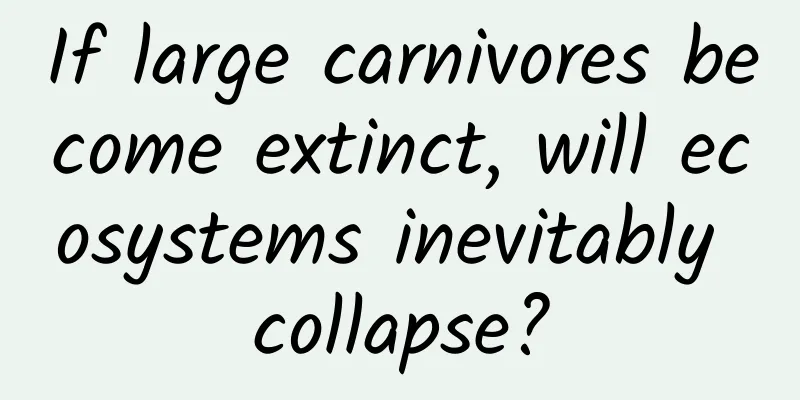If large carnivores become extinct, will ecosystems inevitably collapse?

|
Produced by: Science Popularization China Author: Jia Wei Producer: China Science Expo Perhaps because of their large size, or because humans are at the top of the food chain, we pay more attention to large carnivores that are also at the top of the food chain. Therefore, compared to small, herbivorous animals, we subconsciously think that large carnivores are more important in the ecosystem. People can't help but wonder, if large carnivores become extinct, will the ecological balance be broken, and will the ecosystem eventually be irreparable and collapse? Image source: veer gallery 1. They can be replaced between species at the same trophic level The energy flow, material circulation and information transmission between organisms and between organisms and the inorganic environment in the ecosystem keep them in dynamic balance. At the same time, the ecosystem has the ability to maintain its own stability. It is generally believed that the more complex its food web is, the stronger its self-recovery ability is. In a relatively stable ecosystem, the extinction of a species can be replaced by other similar species. For example, in a grassland ecosystem, when the large carnivore cheetah becomes extinct, the number of herbivorous gazelles will increase sharply in a short period of time, and the amount of grass will also decrease sharply. If there is another carnivore (such as a wolf) in addition to the cheetah, then once the cheetah becomes extinct, the wolves will increase the predation pressure on the deer, and the deer population will not grow too large, thus possibly preventing the collapse of the ecosystem. Wolves and cheetahs are hunting (Photo source: Veer Gallery) In fact, wolves and cheetahs can be at the same trophic level in the food web, and different species at the same trophic level have the same "role", so if cheetahs become extinct, they can be "replaced" by wolves. In detail, different species at the same trophic level can complete the material circulation, energy flow and information transmission functions in the ecosystem to the same extent. Going back to the original hypothesis, if we can find other things that can replace large carnivores and complete the same degree of material circulation, energy flow and information transmission functions in the ecosystem, or if the extinction of large carnivores will not destroy the ecological balance by affecting these three functions, then we believe that the ecosystem will not collapse due to the extinction of large carnivores. 2. Can be replaced during energy flow Therefore, as far as energy flow is concerned, the energy flow is unidirectional and can only flow from the first trophic level to the second trophic level, and then to the subsequent trophic levels in turn. It is irreversible and cannot circulate. The energy decreases step by step during the flow, and the transfer efficiency between two adjacent trophic levels is about 10% to 20%. Therefore, the energy actually obtained by large carnivores is very small, and most of the energy is still concentrated at the bottom of the species, that is, between green plants and herbivores. In other words, even if large carnivores become extinct one after another, the process of energy flow is almost unaffected. Large carnivores can be replaced in the process of energy flow. Almost all the energy on Earth comes from the sun (Image source: veer Gallery) At the same time, the material cycle of the ecosystem refers to the elements such as C, H, O, N, P, etc. that make up the organisms, which are constantly circulating from the inorganic environment to the biological community and then to the inorganic environment. For example, carbon mainly enters the biological community from the inorganic environment in the form of carbon dioxide through the photosynthesis of green plants, and then is transferred between organisms through food chains and food webs, and finally enters the atmosphere from the biological community through the respiration of organisms or the decomposition of decomposers. If large carnivores become extinct one after another, only the respiration of organisms will be affected to a certain extent (for example, the extinction of cheetahs in grassland ecosystems will cause the increase in the number of gazelles, resulting in a corresponding increase in respiration), and the decomposition of decomposers will be minimally affected, so the material cycle of the ecosystem will basically have no impact, and large carnivores can be replaced in the material cycle. Material cycle (Photo source: Panorama Network) 3. Little impact on ecosystem information transmission Finally, in terms of information transmission, after the extinction of large carnivores, the information transmission pattern of the ecosystem will change, but the overall impact will not be too great, because without predators, there is no way to transmit the physical and behavioral information of their predators to herbivores. The vigilance of herbivores will decrease, but the decrease in vigilance will not threaten their own survival. Therefore, even if the extinction of large carnivores affects the information transmission between organisms, it will not cause the ecosystem to collapse. As for the problem of the proliferation of herbivores and other animals that may be worried about, predation is only one of the factors that limit their numbers. The factors that limit the growth of animal populations include endogenous and exogenous factors. Predation is only one of the exogenous factors. Exogenous factors also include diseases, parasites, natural disasters, food restrictions, etc. Endogenous factors include territorial behavior, endocrine regulation, etc. These behaviors will not change in a short period of time because predators suddenly disappear. These factors will limit the growth of other species. Dead deer (Photo source: veer photo gallery) In summary, from the perspective of "collapse", even if all large carnivores become extinct, the ecosystem will not collapse completely. After a long period of evolution, fungi can restore the ecosystem to a state that we do not recognize at all. Even if all plants and animals are gone, bacteria can continue to maintain the activity of the Earth's biosphere. Moreover, the "extinction of large carnivores" will not cause the extinction of many animals. The number of herbivores as food can also be controlled by pathogens, parasites and humans. References: [1] Justine L. Atkins, Ryan A. Long, Johan Pansu, Joshua H. Daskin, Arjun B. Potter, Marc E. Stalmans, Corina E. Tarnita, Robert M. Pringle. Cascading impacts of large-carnivore extirpation in an African ecosystem[J]. Science, 2019, 364(6436). [2] Hoeks Selwyn, Huijbregts Mark AJ, Busana Michela, Harfoot Michael BJ, Svenning JensChristian, Santini Luca. Mechanistic insights into the role of large carnivores for ecosystem structure and functioning[J]. Ecography, 2020, 43(12). |
<<: Why do roosters crow on time every day? Do they know how to calculate time?
>>: The Earth's rotation is getting faster and faster. Is the Earth also "in a hurry"?
Recommend
How to attract traffic and promote on Weibo? The most effective method of attracting traffic on Weibo, easily attracting 500+ precise fans per day
At present, Weibo still has more than 100 million...
Fighting Microsoft and Sony? The Magic Egg Console has become the cloud video chain in the domestic gaming industry
Although Microsoft Xbox One and Sony PS4 have bee...
Can you believe it? Some people can actually smell disease, and a super smeller has confirmed it!
In the novel "Perfume", the protagonist...
Guangdiantong Business Interest Targeting: Showing the right ads to the right people
How to improve marketing effectiveness and commun...
Pitfalls you may encounter when using Android notifications
I've recently encountered some issues with An...
How much does it cost to attract investment for the Nanchong Rubber and Plastic Mini Program? What is the investment quotation of Nanchong Rubber and Plastic Mini Program?
Starting a business requires costs, and mini prog...
The most comprehensive guide to advertising and optimization for Baidu, Tencent, Toutiao, etc.! !
Some time ago, when Tu Zi was browsing the websit...
A real tool! Let you quickly install Apple operating system on VirtualBox
Today, I want to share with you a useful Bash scr...
SAIC Motor: SAIC Motor's cumulative vehicle production in November 2023 was 536,883 units, a year-on-year increase of 16.94%.
SAIC Motor released its November production and s...
Will Google's driverless car be launched in Shanghai? Shanghai is trying to get Google's driverless car to be launched in Shanghai
This evening, the Shanghai Economic and Informati...
The game genres with the most development potential in the next ten years
In May this year, I mentioned at the end of the a...
Xiaona is gone, Microsoft Xiaobing is back, are voice assistants really useful?
After Windows 10 2004 separated Cortana and the s...
The logic behind internet celebrity brand marketing success!
The popular Wang Baobao is at the center of the n...
Baotou SEO Training: How to quickly improve website inclusion and weight?
How to increase website entry? 1.URL submission T...
Operational strategies for community operations!
The article reviews the development of a check-in...









